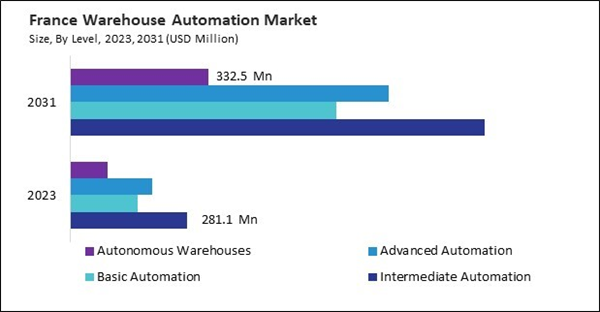The Germany market dominated the Europe Other Applications Market by Country in 2023, and would continue to be a dominant market till 2031; thereby, achieving a market value of $420.3 million by 2031. The UK market is exhibiting a CAGR of 17.3% during (2024 - 2031). Additionally, the France market would experience a CAGR of 19.6% during (2024 - 2031).
Automation technologies are employed to handle hazardous materials safely. Automated systems can manage the storage, retrieval, and transportation of dangerous goods, minimizing human exposure and reducing the risk of accidents.
Moreover, automated systems ensure compliance with safety regulations by monitoring environmental conditions and maintaining accurate records of hazardous material handling. Automation systems facilitate returns processing by automating the inspection, sorting, and restocking returned items.
The UK aerospace sector, with major players like BAE Systems and Rolls-Royce, requires advanced manufacturing capabilities. Automated warehouses support these requirements by handling sophisticated inventory management systems and precise materials handling. According to the International Trade Administration (ITA), in 2022, UK civil aerospace turnover totaled approximately $34.5 billion. The United Kingdom space industry generated an estimated $22 billion in revenue in 2021, of which $9.5 billion was allocated for exports. Furthermore, by 2030, the impact of drones could increase the UK’s GDP by $53 billion. The aerospace sector involves complex supply chains with numerous suppliers and components. Warehouse automation helps manage these intricate supply chains more effectively, ensuring timely delivery of parts and materials for aerospace manufacturing.
Based on Component, the market is segmented into Hardware (Autonomous Robots (AGV, AMR), Automated Sorting Systems, Automated Storage & Retrieval Systems (AS/RS), De-palletizing/Palletizing Systems, Conveyor Systems, and Automatic Identification & Data Collection (AIDC)), Software (Warehouse Management System (WMS), Warehouse Execution Systems (WES), and Labor Management Systems (LMS)), and Services (Installation & Integration, Consulting, Training & Education, Maintenance & Support, and Analytics & Reporting Tools). Based on Level, the market is segmented into Intermediate Automation, Basic Automation, Advanced Automation, and Autonomous Warehouses. Based on Application, the market is segmented into Retail & E-commerce, Automotive, Aerospace & Defense, Healthcare, Electronics & Semiconductors, and Other Applications. Based on countries, the market is segmented into Germany, UK, France, Russia, Spain, Italy, and Rest of Europe.
List of Key Companies Profiled
- Honeywell International, Inc.
- Murata Machinery, Ltd.
- Knapp AG
- ABB Group
- FANUC Corporation
- Kuka AG (Midea Group Co., Ltd.)
- Jungheinrich AG
- KION GROUP AG
- Daifuku Co., Limited
- Omron Corporation
Market Report Segmentation
By Component
- Hardware
- Autonomous Robots (AGV, AMR)
- Automated Sorting Systems
- Automated Storage & Retrieval Systems (AS/RS)
- De-palletizing/Palletizing Systems
- Conveyor Systems
- Automatic Identification & Data Collection (AIDC)
- Software
- Warehouse Management System (WMS)
- Warehouse Execution Systems (WES)
- Labor Management Systems (LMS)
- Services
- Installation & Integration
- Consulting, Training & Education
- Maintenance & Support
- Analytics & Reporting Tools
By Level
- Intermediate Automation
- Basic Automation
- Advanced Automation
- Autonomous Warehouses
By Application
- Retail & E-commerce
- Automotive
- Aerospace & Defense
- Healthcare
- Electronics & Semiconductors
- Other Applications
By Country
- Germany
- UK
- France
- Russia
- Spain
- Italy
- Rest of Europe
Table of Contents
Companies Mentioned
- Honeywell International, Inc.
- Murata Machinery, Ltd.
- Knapp AG
- ABB Group
- FANUC Corporation
- Kuka AG (Midea Group Co., Ltd.)
- Jungheinrich AG
- KION GROUP AG
- Daifuku Co., Limited
- Omron Corporation
Methodology

LOADING...









